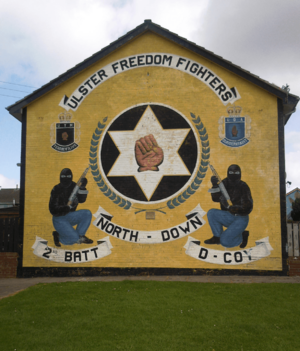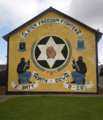Force Research Unit facts for kids
Quick facts for kids Force Research Unit |
|
|---|---|
| Active | 1982–2007 |
| Country | |
| Branch | |
| Type | Military intelligence unit |
| Role | Agent handling Black operation Clandestine human intelligence Clandestine operation Close-quarters combat Counterinsurgency Counterintelligence Countersurveillance Counterterrorism Covert operation Direct action Espionage HUMINT Intelligence assessment ISTAR Military intelligence Raiding Special operations Special reconnaissance Surveillance |
| Part of | Intelligence Corps |
| Engagements | Operation Banner (The Troubles) |
The Force Research Unit (FRU) was a secret military intelligence group. It was part of the British Army's Intelligence Corps. The FRU was started in 1982 during the Troubles in Northern Ireland. Its main job was to get information from illegal armed groups. They did this by finding and working with secret agents and informants. From 1987 to 1991, Gordon Kerr was in charge of the FRU.
The FRU worked with other intelligence groups. These included the Special Branch of the Royal Ulster Constabulary and MI5. In 1988, a special team called the All-Source Intelligence Cell was created. This team helped the FRU, Special Branch, and MI5 share information better.
Later, the FRU changed its name to the Joint Support Group (JSG). This happened after special investigations called the Stevens Inquiries. These investigations looked into claims that the FRU had secretly worked with loyalist groups. The Stevens Inquiries found that the FRU had indeed helped loyalist groups. Some former members of the FRU have also said this is true.
Working with Loyalist Groups
In the mid-1980s, the FRU recruited Brian Nelson. He became a secret agent inside the Ulster Defence Association (UDA). The FRU helped him become the UDA's main intelligence officer. The UDA was a loyalist group. It was involved in many attacks on Catholic and nationalist civilians. It also attacked republican groups. The UDA was not made illegal until 1992.
In 1988, weapons were sent to loyalists from South Africa. Brian Nelson helped to manage this.
Through Nelson, the FRU helped the UDA choose people to harm. In 2003, the BBC reported on this. FRU commanders wanted to make the UDA "more professional." They aimed to help the UDA target and harm republican activists. They also wanted to stop the UDA from harming innocent Catholic civilians. If someone was in danger, agents like Nelson were supposed to tell the FRU. The FRU would then tell the police. Gordon Kerr led the FRU from 1987 to 1991. He said Nelson and the FRU saved over 200 lives this way.
However, the Stevens Inquiries found different information. They found evidence that only two lives were saved. They also said many loyalist attacks could have been stopped. But these attacks were allowed to happen. The Stevens team believes Nelson was involved in at least 30 killings. He was also involved in many other attacks. Many of the people harmed were innocent civilians. One well-known case was solicitor Pat Finucane. Nelson was put in prison in 1992. But FRU information continued to help the UDA and other loyalist groups. From 1992 to 1994, loyalist groups caused more deaths than republican groups. This was the first time this had happened since the 1960s.
There are claims that the FRU asked for "restriction orders." These were agreements to stop patrols or watching an area for a certain time. This was done before some loyalist attacks. It would make it easier for the attackers to get in and out. This activity happened at a weekly meeting. Representatives from the Royal Ulster Constabulary, MI5, and the British Army were there. It is claimed the FRU asked for these orders. They did this for areas where loyalist groups were planning attacks.
Allegations of Infiltrating Republican Groups
The FRU is also said to have worked with agents inside republican groups. Some agents are thought to have been controlled by the FRU. These included members of IRA units. These units planted bombs and carried out planned killings. Attacks are said to have happened involving FRU-controlled agents. These agents were in high positions within the IRA.
It is thought that the FRU tried to influence the IRA through an agent. This agent was known by the codename "Stakeknife". He was believed to be a member of the IRA's Internal Security Unit. This unit was in charge of finding informers within the IRA. There is a discussion about whether this agent was IRA member Freddie Scappaticci or someone else. It is believed that "Stakeknife" was used by the FRU. He helped to change the results of investigations. These investigations were done by the IRA's Internal Security Unit. They looked into the actions of IRA members.
It is claimed that in 1987, the UDA found out who "Stakeknife" was. They did not know how important this IRA agent was to the FRU. So, they planned to harm him. It is said that the FRU found out "Stakeknife" was in danger. They then used Brian Nelson to convince the UDA to harm Francisco Notarantonio instead. He was an elderly man from Belfast. He had been held as an Irish republican in the 1940s. The UFF claimed responsibility for Notarantonio's killing at the time. After Notarantonio was killed, the IRA harmed two UDA leaders. They did this in revenge. They did not know the FRU was involved. It has also been claimed that the FRU secretly gave details about the two UDA leaders to the IRA. They did this through "Stakeknife." This was done to make people less suspicious of "Stakeknife" as an informer.
Images for kids



